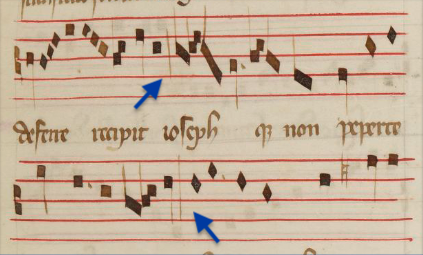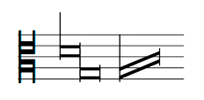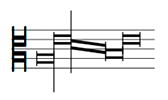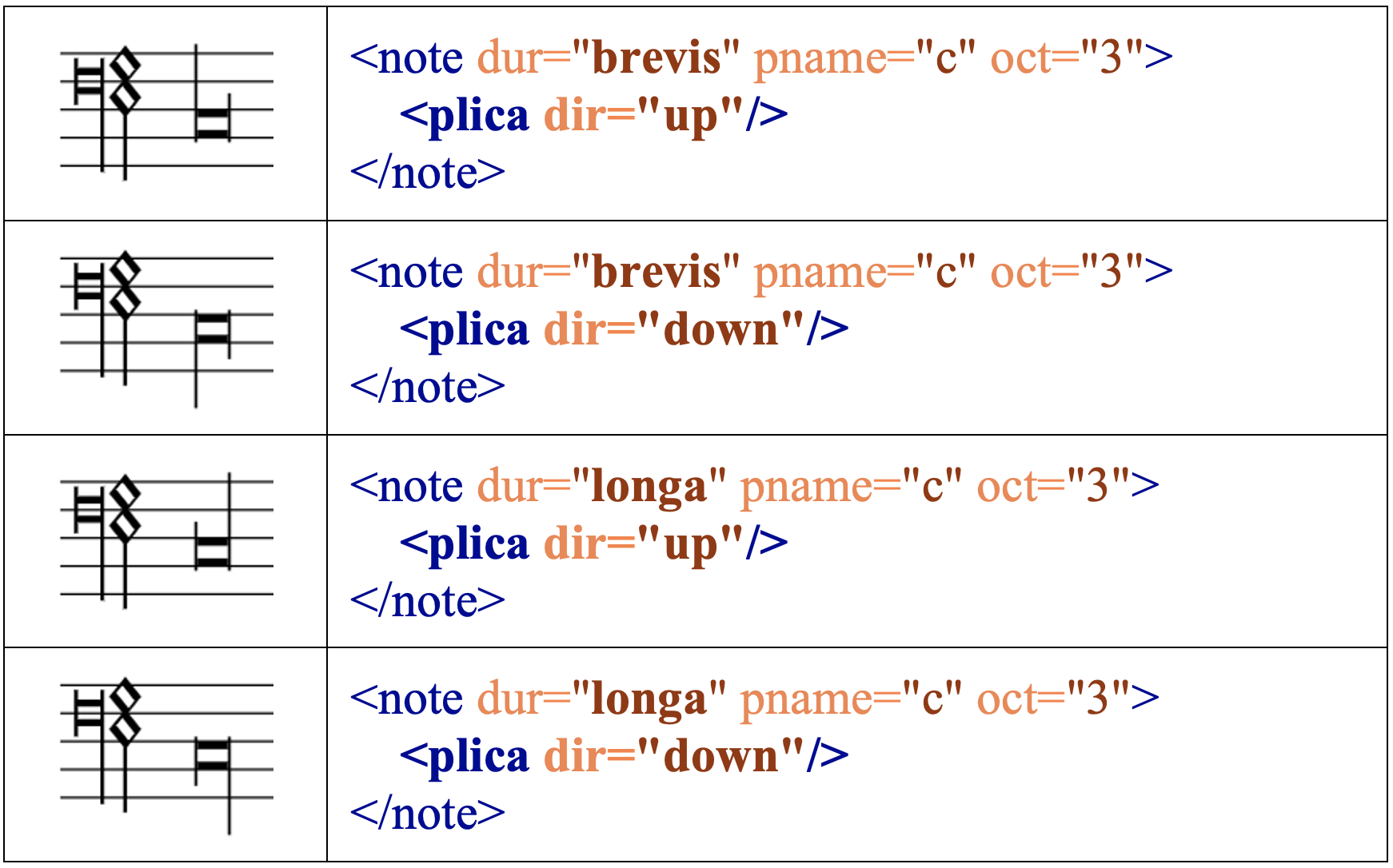5.1 Durations5.1.1 Alteration and Imperfection5.1.2 Partial Imperfection5.2 Mensuration5.2.1 Change in mensuration5.2.2 Implicit mensuration5.2.3 Italian Divisiones5.3 Proportions5.4 Ligatures5.5 Music Data Organization5.6 Other Features5.6.1 Notation Type5.6.2 Stems5.6.3 Plicas5.6.4 Dots5.6.5 Accidentals5.6.6 Coloration5.6.7 Custos
5Repertoire: Mensural Notation
This chapter describes the module for encoding mensural notation from the late 13th century to about 1600. Historically, mensural notation preceded the development of Common Music Notation (CMN) and it included a wide range of features that persist in CMN and that can be encoded in a standard manner in MEI. In mensural notation, pitches are notated as in CMN, leaving out here the major exception of musica ficta. The pitch is given by the position of the note on the staff and the current clef as in CMN, and the mensural module introduces no modification to MEI regarding how pitches are encoded.
There are a number of differences, however, in the representation of duration in mensural notation. The mensural module introduces specific attribute values for notes and rests for appropriately encoding mensural durations. One of the main differences is that the duration of a note is not determined by its symbol, but also by the meter and the context in which the symbol appears in relation to other notes and rests in the same voice. The meter is given by one of the 16 mensural species provided by four levels of division: modus major, modus minor, tempus and prolatio. In the case of triple meter and depending on the specific context where the note is positioned, certain rules must be applied in order to determine the duration of a note. In these cases, encoding both the sign and its actual duration is highly recommended (as will be shown in 5.1 Durations).
Another difference is the use of proportions that are indicated by numeric ratios or by specific mensuration signs. The proportions indicate that the durations have to be modified and they may be combined. Proportions and mensuration signs were eventually simplified and became time signatures in CMN. The attributes and elements available in this module for encoding mensural signs and proportions can be found below (see 5.2 Mensuration and 5.3 Proportions).
In mensural notation, notes can also be notated in ligatures that regroup two or more notes. Ligatures were a legacy from an earlier notation system that were still widely used in Renaissance music notation. They gradually disappeared during the seventeenth century. The mensural module provides multiple ways of encoding the ligatures.
5.1Durations
When the mensural module is included, @dur on <note>, <rest>, and other elements takes the following values (from the Latin names of notes):
maxima: Two or three times as long as a longa
longa: Two or three times as long as a brevis
brevis: Two or three times as long as a semibrevis
semibrevis: Half or one-third as long as a brevis
minima: Half or one-third as long as a semibrevis
semiminima: Half as long as a minima
fusa: Half as long as a semiminima
semifusa: Half as long as a fusa
Normally, longa rests are vertical strokes occupying two or three spaces in the staff, depending on the mensuration. For instance, in @modusminor="3", they take up three spaces; and in @modusminor="2", they take two. However, there are situations where both types of longa rests can be present in the same piece, regardless of the modus minor. For this reason, the @dur attribute can take on two other values when used within <rest> elements:
2B: Two-breve rest
3B: Three-breve rest
The example below illustrates this case in a passage in perfect modus from the triplum voice of a motet in the Roman de Fauvel music manuscript. The blue arrows on the image are pointing to the two-breve and three-breve rests in this passage.

5.1.1Alteration and Imperfection
In ternary mensurations, the ambiguity between the note shape and its actual duration requires specific attention. The rules of mensural notation can require the alteration or the imperfection of a note; that is, an increase or reduction in its performed duration. In these cases, if the encoding is intended to be used for more than just graphically representing the notation, encoding only the note shape by means of the @dur attribute alone is insufficient. In that case, in addition to encoding the duration sign in the @dur attribute, it is recommended to encode its performed duration in the @dur.quality attribute. The @dur.quality attribute specifies the length of a note according to the contextual rules of mensural notation. Its values, listed below, are adopted from the original Latin terms:
perfecta: Three times the duration of the note in the next smaller degree
imperfecta: Two times the duration of the note in the next smaller degree
altera: Twice the original duration of the note (only usable in perfect mensurations)
minor: Category of a regular semibrevis in Ars antiqua, equivalent to a third of a brevis
maior: Category of an altered semibrevis in Ars antiqua, equivalent to two minor semibrevis
duplex: One of the three categories of a longa in Ars antiqua ('duplex', 'perfecta', and 'imperfecta')
The last three values are to be used exclusively in Ars antiqua mensural notation, where maior and minor refer to types of semibreves, and duplex refers to a type of longa. Examples of each of these six values are presented below. In these examples, the ‘voice’ staff renders the notes in the code snippet, and the ‘reference’ staff, together with the dotted bar lines, are shown to help to visualize the relative values of the notes in the ‘voice’ staff.
The following example illustrates an alteration (the second brevis) in modus minor perfectus. Notice that the second brevis has doubled its regular value, it has been altered, unlike the first one.
It is possible to omit the @dur.quality attribute in a note when the performed duration of the note is the default value
provided by the mensuration. In this case, the longas are perfect, just as the mensuration (perfect modus minor) indicates. Therefore, the @dur.quality attribute can be omitted for the two longas.
The following example illustrates an imperfection (the two longae) in modus minor perfectus with the same longa-brevis-brevis-longa sequence but with an additional dot of division between the two breves (see 5.6.4 Dots for more details). Notice that here the longae have been imperfected, unlike the previous example in which they kept the perfect
value indicated by the mensuration.
The following example in modus minor imperfectus illustrates the use of a dot of augmentation following the longa (see 5.6.4 Dots for more details). Notice that the longa, which is supposed to be imperfect according to the mensuration, has a perfect value
due to the augmentation dot.
Finally, the following example illustrates the @dur.quality values related to the Ars antiqua style, for perfect modus, with the breve equivalents notated in the lower staff for reference (as in the previous
examples).
Note: In Ars Antiqua, only the longa could be "perfecta" / "imperfecta" and the brevis could have a regular value ("recta") or be "altera". In the Ars nova, principles of imperfection and alteration were extended into the other note levels (brevis-semibrevis and semibrevis-minima). This means that the breves in Ars antiqua do not have a "perfecta" / "imperfecta" quality, and this is why there is no @dur.quality attribute for the breves in the previous example. However, the brevis can have a ternary division (indicated by @tempus="3"), being divided either into three (equal) minor semibreves or into a minor-maior pair of semibreves. The encoding also allows for the possibility of encoding a binary division of the breve in Ars antiqua notations: the indication @tempus="2" indicates the breve is divided into two equal semibreves. This is why in this example with @tempus="3", the semibreves do have a @dur.quality attribute (with values minor or maior).
An alternative encoding---removing the @dur.quality attributes for notes which lengths are not modified from their default values (i.e., the perfect long and the minor semibreves)---would be:
The conjunct use of the @dur and @dur.quality attributes is generally enough to encode the duration of a note—and, as indicated before, one could even remove @dur.quality when its value is in agreement with the mensuration. However, there are cases (e.g., partial imperfection) where the values of @dur.quality are not enough to provide the note’s duration.
5.1.2Partial Imperfection
In opposition to regular imperfection, which is caused by a note of the next smaller degree (e.g., a perfect brevis imperfected by a following/preceding semibrevis), partial imperfection is caused by a note of two or even three orders apart. As an example, consider an imperfect longa made up of two perfect breves. This longa can be ‘partially imperfected’ by a following/preceding semibrevis. This semibrevis causes part of the longa—one of its perfect breves—to be imperfected, taking away one-third of one of its two halves. In this case, the longa’s value changes from 6 semibreves (two perfect breves) into 5 semibreves. Partial imperfection is not supported by the @dur.quality attribute—because there can be many cases of partial imperfection, as will be seen in the following examples. To encode a partial imperfection, the @num and @numbase pair of attributes are used instead. Given the change in the longa’s value from 6 semibreves to 5 semibreves, the corresponding attributes to encode this particular case of partial imperfection would be @num="6" and @numbase="5" as shown below in the code snippet and its rendering.
Partial imperfection can also happen from both sides of a note at once, as shown below:
An example of partial imperfection caused by a note three orders apart is given next. Here the longa is partially imperfected by a minima (instead of by a semibrevis).
In the next example, the longa is also imperfected by a minima. However, the @num and @numbase ratio is different from the example above because the default value of the longa here (18 minimas) is different from that of the previous example (12 minimas).
5.2Mensuration
Using the mensural module, mensuration signs can be indicated with the attributes available on the <scoreDef> and <staffDef> elements. Mensuration signs encoded using attributes on <scoreDef> are regarded as default values which may be overridden by values attached to individual <staffDef> elements.
The division levels corresponding to modus maior, modus minor, tempus, and prolatio can be encoded in the @modusmaior, @modusminor, @tempus, and @prolatio attributes respectively. Their value must be 3 (perfect) or 2 (imperfect).
The mensur signs themselves can be encoded in the @mensur.sign attribute with a possible value of C or O. Its orientation can be encoded in the @mensur.orient attribute, for example, with the value reversed for a flipped C sign. The number of slashes (up to 6) can be given in the @mensur.slash attribute. There is also a @mensur.dot attribute for indicating the presence of a dot through the boolean values true or "false".
<mensur> elements can also be used instead of <staffDef> and its attributes. In <mensur>, the division levels are encoded with the previously mentioned @modusmaior, @modusminor, @tempus, and @prolatio attributes, while the attributes to indicate the mensur signs are: @sign, @orient, @slash, and @dot. <mensur> can be a child of the <staffDef> and <layer> elements.
5.2.1Change in mensuration
The following example illustrates a change in mensuration. In this case, the element <mensur> is used within the <layer> element, preceding the stream of notes affected by the new mensuration defined by
it.
Sesquialtera is frequently used to change the mensuration. The effect of the sesquialtera on the mensuration can be encoded by using the @tempus and @prolatio attributes of <mensur> (for example, when changing the tempus to perfect, the effect can be encoded in @tempus="3"). The actual sesquialtera can be encoded using @num="3", @numbase="2", and @level to define the note level the sesquialtera is applied to (e.g., @level="semibrevis").
5.2.2Implicit mensuration
It is common in Ars antiqua and some Ars nova pieces to have no mensuration signs. In this case, the mensuration—the division levels
corresponding to modus maior, modus minor, tempus, and prolatio—is given by the context. The next example shows the incipit of a four-voice piece,
Josquin’s Tu solus qui facis mirabilia, where only two of the voices (Cantus and Tenor) have a mensuration sign. The other two (Altus and Bassus) have no mensuration signs, and the mensura is given by the context. Therefore, while only the Cantus and the Tenor have attributes for encoding the mensuration sign (in this case, @mensur.sign and @mensur.slash), all four voices include attributes to encode the mensura (@tempus and @prolatio).
5.2.3Italian Divisiones
The division of the breve in Italian trecento notation can be encoded using the @divisio attribute, which provides the values: ternaria, quaternaria, senariaimperf, senariaperf, octonaria, novenaria, duodenaria. The @divisio attribute would usually replace the use of the @tempus and @prolatio set of attributes.
The signs for the Italian divisiones can be encoded in the @sign or @mensur.sign attribute (to be used with @mensur or @staffDef respectively), with the values: t for ternaria, q for quaternaria, si and i for senaria imperfecta, sp and p for senaria perfecta, oc for octonaria, n for novenaria, and d for duodenaria. And the additional values for senaria gallica, sg and g, and senaria ytalica, sy and y.
5.3Proportions
Proportions can also be indicated within the <staffDef> element. The @proport.num and @proport.numbase attributes are available for encoding the numerator and the denominator of the proportion, respectively. There is also a <proport> element that can be used as an alternative, with the corresponding @num and @numbase attributes.
5.4Ligatures
Ligatures can be encoded using the <ligature> element. The @form attribute is available for specifying if the ligature is recta or obliqua.

In cases where the ligature contains both recta and obliqua notes, the @lig attribute of the <note> element can be used to specify the form of the ligature at the note level.

5.5Music Data Organization
The data organization based on <measure> elements that usually prevails in MEI is not appropriate for mensural notation because most music until 1600 does not have measures (bars) as we understand them today. Even though it is not defined by the mensural module, a more suitable alternate data organization without measures is available: <staff> elements may occur directly within the <section> element without being organized into measures first. The organization of events (notes, rests, etc.) within the <staff> and <layer> elements remains unchanged.
This feature may also be used to encode measured music without using the <measure> element. That is, the same data organization described above may be used, but with the addition of bar lines, indicated by the <barLine> element, for those situations where a measure-by-measure organization is not appropriate, for example, when measures are not coincident in all the staves of a score.
5.6Other Features
Other features included in the MEI schema that allow for the encoding of various mensural notation properties are presented below:
5.6.1Notation Type
The @notationtype attribute, part of the MEI module, can be used within the <staffDef> element to specify which dialect of mensural notation is in use.
At the moment, three values are in use for mensural notation:
mensural: For mensural notation in general
mensural.black: For black mensural notation, this is in reference to the use of filled-in note heads
mensural.white: For white mensural notation, this is in reference to the use of void note heads, which became most widely used in the Renaissance period
The values of the @notationtype attribute can indicate notation types other than mensural, such as common (Western) music notation, neume notation, and tablature.
The attribute @notationsubtype can be used, together with the @notationtype attribute, to provide more specificity regarding the type of notation encoded. This attribute can be used, for example, to specify if a piece in black mensural notation (@notationtype="mensural.black") is written in Ars antiqua or Ars nova style. Currently, the values allowed in the @notationsubtype attribute consist of any sequence of characters provided by the user.
Important: An element with a @notationsubtype attribute must have a @notationtype attribute.
5.6.2Stems
The characteristics of a note’s stem can be encoded within the <note> element, using the attributes:
[include example (image and code) of a note with one stem that includes many of these attributes]
Sometimes notes have two stems. In this case, the <stem> element can be used as a child of <note> to define the individual characteristics of each stem with the following attributes:
[include example (image and code) of a note with two stems]
5.6.3Plicas
Plicas can be encoded using the <plica> element as a child of <note>. The direction of the plica, as well as its length, can be encoded using the following visual-domain attributes:

5.6.4Dots
Dots of division and augmentation can be encoded by using the <dot> element (provided by the MEI.shared module). This element is meant to be used as a child of <layer> following the <note> or <rest> after which it appears in the original source.
Dots in mensural notation are not encoded as children of notes or rests, but rather as a sibling of these. They are also not encoded as attributes (the use of the @dot attribute in a <note> or <rest> element is only acceptable in Common Music Notation, not mensural).
To indicate the nature of the dot (as a dot of division or augmentation), the <dot> element has an attribute @form, which can take on the following values:
aug: Value of the form attribute for a dot of augmentation (this is a dot that adds half the value to the previous note, like a dotted note in common Western music notation)
div: Value of the form attribute for a dot of division (this is a dot that modifies the perfect groupings of the notes, thus, changing some notes' duration in the process)
The actual effect of these dots (augmenting a note and making it perfect, or dividing a sequence of notes in different groupings by imperfecting some notes or altering others) is encoded with the @dur.quality attribute of the correspoding <note> elements. Examples of the use of dots of division and augmentation can be found in the 5.1.1 Alteration and Imperfection section.
5.6.5Accidentals
[explain that accidentals are usually encoded as independent elements and that accid.ges can be used within notes]
5.6.6Coloration
[explain where/how coloration can be encoded]
5.6.7Custos
[explain that there is a custos element available]










